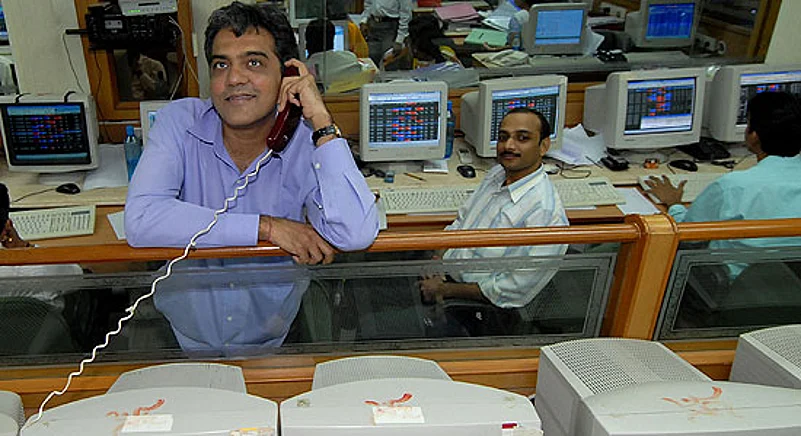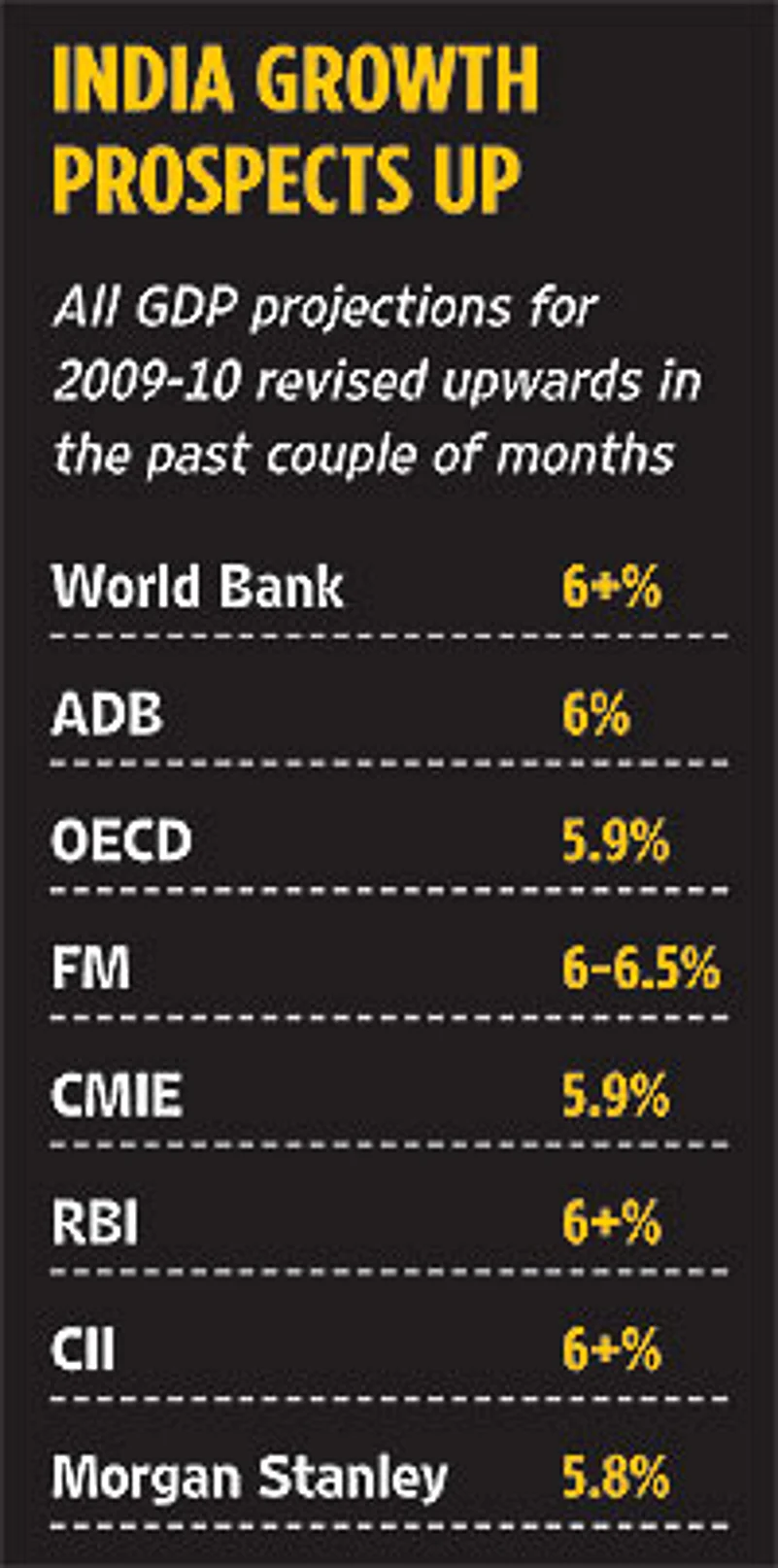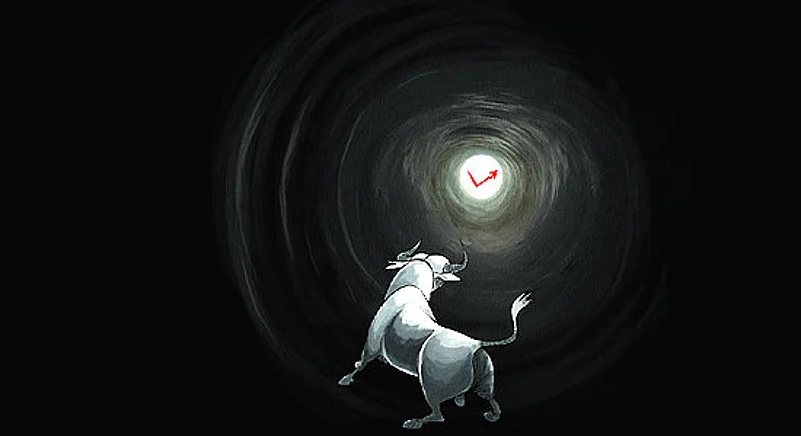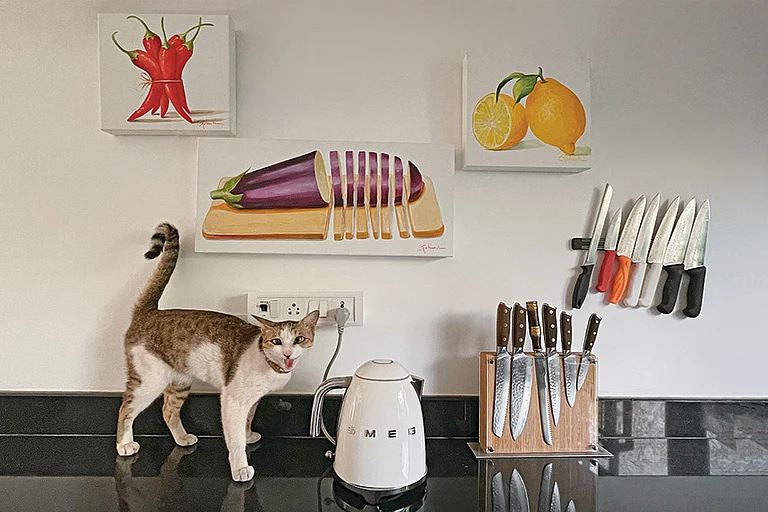Signals From The Economy
The Good
- Government stimulus: Higher state spending on infrastructure and liberal doling out of cash-in-hand is helping perk up the economy.
- Real Estate: Pickup in demand, particularly for completed projects, with banks offering attractive home loan rates. Prices up by 5-15%.
- Bank Credit: Has gone up marginally. Credit offtake expected to have a stronger recovery by about 20 per cent in the next two quarters.
- Manufacturing: Industrial production has been on an upswing—albeit intermittently—for the last couple of quarters.
- Corporate Bottomlines: Surprisingly good results in Q1 2009, thanks largely to ruthless cost-cutting; tax collections up.
- Retail: After a long lull, finally there are some signs of revival. Festive demand is expected to further push up sales.
The Not So Good
- Infrastructure: Not as much money poured into the system as expected, despite generous announcements. Government-given contracts for roads, for instance, still need to pick up steam.
- Employment: Hiring on but at slow pace, particularly in the informal sector. Good news tempered with lower salaries, cut in social security benefits.
- Drought: Late rains may help winter crops; for now more price pressure on food, while rural incomes may be hit.
The Uncertain
- Exports: While the decline has reduced, exports are limping. Services exports await better sentiments overseas.
- Inflation: WPI turns positive, expected to rise and possibly reach 6 per cent by March '10. This will put pressure on the RBI to hike interest rates marginally.
- Stockmarkets: Buoyed by a rush of foreign money, the market looks attractive, particularly for long-term investors. But experts warn of some course correction.
***
After the trials and tribulations of a wretched year, it’d be perfectly natural to downplay any signs of recovery. But over the past few weeks, the trickle of good news has grown stronger. There’s now even a sense of deja vu with the Sensex staring at 17000 and beyond. Boosted by $10 billion in foreign funds this year, the bellwether of market opinion has registered a jaw-dropping 73 per cent rise this year. Even after discounting the emotional exuberance, it’s time to gingerly pop a few questions. Has India finally emerged out of the pressures of the global economic slowdown? Are we ready to clock higher growth?
Banking on government-led stimulus—particularly higher investments in roads and power—many reputed global agencies definitely feel so. They have raised expectations of India’s economic growth in 2009-10 from around five per cent to 6 per cent or more. For the next fiscal, some are even optimistic about over 8 per cent growth. “Markets started rising rapidly on the back of improved expectations and liquidity. Over the next 3-5 years, in emerging markets like India and China these expectations could be realised and surpassed,” avers Krishnamurthy Vijayan, executive chairman, JP Morgan Asset Management.
Indeed, many explain the changed targets as a mirror of the stockmarket’s heady rise. Or vice-versa. So there are indeed some indicators here, but market experts still feel that current valuations are unreasonable, even uncomfortable—they haven’t yet seen any dramatic change in corporate results, output or even credit offtake. There’s also the spectre of deficient monsoons and looming inflation, which could have a drag effect. “It’s like cancer. Just because you’re undergoing radiation therapy doesn’t mean you’re out of the woods,” warns the head of a broking firm.
Most seasoned market participants privately admit that the market has grossly outrun reality. It’s important to remember here that a lot of what is driving the market today is not fundamentals—as it is the excess liquidity that has been generated by central banks across the world that has found its way to India. It is expected that once central bankers start the tightening process, there should be a slowing down in the money flow.

Of course, there is good news, or at least straws in the wind. The government’s attempt to provide stimulus through a benign interest rate regime and tax adjustments have paid off in many sectors. In less than a year, the real estate sector has started looking up as prices have stabilised and even risen 5-15 per cent in some cities with the middle and upper middle class back in investment mode. However, despite what seems a recovery, many feel it’s too early to bring out the bubbly. Rather than looking at new projects or acquiring fresh land, the focus is now on offering existing inventory at good prices.
The changed mood of course has lots to do with easy availability of cheaper loans. This is leading to expectations of an increase in credit offtake, with bankers expecting it to grow 20 per cent in the coming two quarters. But that’s in the future as, according to the RBI, credit growth till August-end was 14 per cent compared to over 24 per cent the same time last year. Domestic demand and consumption will have to pick up for credit offtake to increase.
There has also been a pick-up in demand for workers, both skilled and unskilled, after a gap of several months when lakhs were laid off or faced wage cuts. “The good news is that construction workers are getting more work as real estate looks up. Some of the big exporters, including diamond units, have started working full time, while small factories have increased operations to 4-5 days,” says Renana Jhabvala, national coordinator of the Ahmedabad-headquartered SEWA. Unfortunately, the revival in job demand in small and medium units is not necessarily reflected in higher wages. At the other end of the spectrum, reports of medium and large companies hiring top managerial talent is back in circulation.
With urban consumers back to spending (though more cautiously), the manufacturing industries are looking at higher growth. “It’s early days but it looks as though the industrial sector will contribute more strongly to quarterly GDP growth in the July-September quarter than it did in the April-June period,” says Robert Prior-Wandesforde, Senior Asian economist at HSBC. A step-up in private sector investments is indeed being noticed, with many looking at options to raise funds, including through IPOs, which was impossible last year. The government too has recorded over 50 per cent jump in advance taxes by companies, pointing to improved recovery.
Indian companies are indeed bolder now—but M&A activity remains 40 per cent down in deal value terms. Arvind Mahajan, executive director of KPMG, prefers to remain “cautiously optimistic in the current situation”, saying the recovery will be “demand-driven”. The bottomline: only another quarter of sustained growth could be seen as indicative of a stronger, longer-term recovery.
There are still many labour-intensive sectors, many of them export-driven, that are yet to register desirable levels of growth. Global trends will have a strong influence here. Though merchandise exports account for just 20 per cent of the GDP, together with services exports (ITES has a big share here), the overall share of exports is about 40 per cent, points out Planning Commission member Abhijit Sen. With the world economy expected to record less than half the desired four per cent growth over the next 5-6 years, there are fears that exports will take a longer time to recover.
A. Sakthivel, president of export body FIEO, says exports have started limping back. “Queries have started coming in, but more for medium- and low-value segments like textiles, garments and leather. High-value products like gems and jewellery, automobiles etc are still to pick up,” he says. Government support to explore new markets should help maintain last year’s exports levels. M. Rafeeque Ahmed, chairman, Farida group of companies, a leading leather goods exporter, avers, “Things are not any different on the ground than six months ago. Only the feeling has changed...and that won’t run a business.”
Amidst all the optimism, the impact of drought, particularly on the rural economy, is being overlooked. Though the overall management of drought has been much better this year compared to 2002, there is no ruling out that delayed rainfall and the 22 per cent deficiency in the monsoon will start showing an impact. “There are green shoots of revival but we seem to be in a bit of denial about the drought impact,” states Sen. The next two quarters are crucial as the harvest in September-October and the winter crops will show the impact.

The WPI has just turned positive, but there are expectations that by year-end policymakers will have to face the challenge of inflation, with high food prices continuing to exert pressure. “Right now, we are doing a tightrope walk to control food inflation, which cannot be checked by monetary policy. There is a clear sign of weak recovery, but there are challenges ahead as the government has to unwind the stimulus and reduce fiscal deficit,” says D.K. Joshi, principal economist, CRISIL.
When to switch to a tight monetary regime would be a tough call to make. Experts feel it can happen only when the economy is on a decisive recovery path, not the case as yet with domestic consumption still weak. Besides a negative growth of 1-1.5 per cent foreseen in agriculture, the rising commodities prices have started exerting pressure in many sectors. By year-end, experts expect the RBI to raise interest rates to mop up excess liquidity to check inflation, expected to reach 6 per cent by March. “The monetary and fiscal stimulus will eventually cause its own distortions,” warns Sanjeev Sanyal, economist and president of The Sustainable Planet Institute.
So the big picture then is not too gloomy. Though the global economy is still to recover and despite the challenges of a bad drought, India is doing much better than expected. With exports limping back and manufacturing looking up due to cautious consumer optimism, a job market which had bottomed out should pick up on global cues. On the flip side, gaps in infrastructure and ad-hoc agriculture policies, as in the case of sugarcane, could sour the dream of a strong revival. For now, it’s mind over matter.
By Lola Nayar, Arti Sharma and Pragya Singh


























